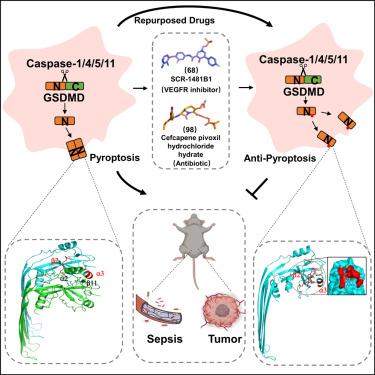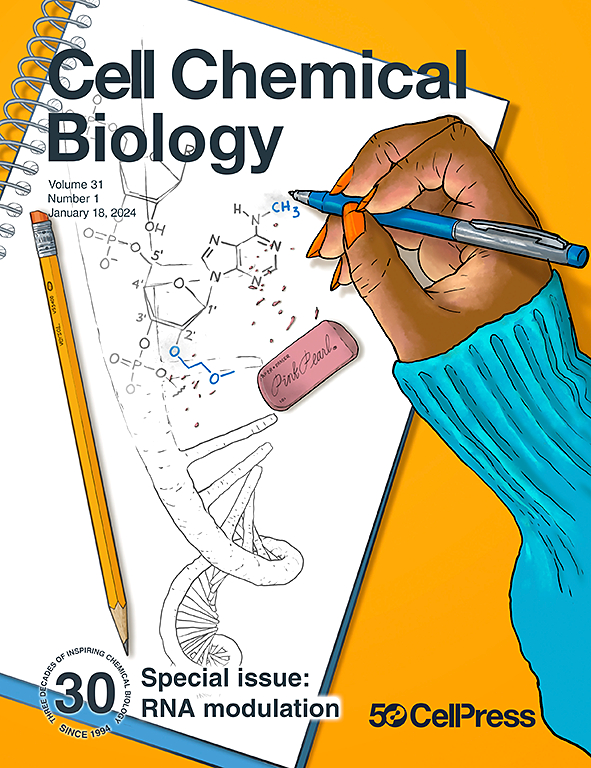鉴定两种以 GSDMD 寡聚界面 I 为靶点的再利用药物,以阻断焦细胞增多症
IF 7.2
1区 生物学
Q1 BIOCHEMISTRY & MOLECULAR BIOLOGY
引用次数: 0
摘要
作为化脓过程的执行者,gasdermin D(GSDMD)在炎症性疾病和癌症中起着至关重要的作用。因此,GSDMD 目前正被作为药物靶点进行广泛研究。现有的以 GSDMD 为靶点的抑制剂,如新磺酰胺、二磺酰胺和富马酸盐,主要通过修饰 GSDMD N 端片段中的人/鼠 C191/C192 来阻止热蛋白沉积。然而,半胱氨酸修饰会妨碍重要蛋白质或酶的功能,从而导致不良反应。在此,我们选择了 GSDMD 激活的另一个关键干预位点,该位点位于其孔形成结构的寡聚界面 I。通过高通量虚拟和实验筛选,并结合药效和药理验证,我们发现了两种安全、特异的 "再利用药物",它们能有效抑制 GSDMD 介导的热蛋白沉积。此外,这些候选药物在小鼠败血症和肿瘤发生模型中表现出了 "1 + 1>2 "的协同治疗效果。这些最新发现的 GSDMD 抑制剂有望在抗炎和抗癌免疫疗法的开发中实现临床转化。本文章由计算机程序翻译,如有差异,请以英文原文为准。


Identification of two repurposed drugs targeting GSDMD oligomerization interface I to block pyroptosis
As an executor of pyroptosis, gasdermin D (GSDMD) plays a critical role in inflammatory diseases and cancer. Thus, GSDMD is currently being widely explored as a drug target. Existing inhibitors targeting GSDMD, such as necrosulfonamide, disulfiram, and fumarate, primarily prevent pyroptosis by modifying human/mouse C191/C192 in the N-terminal fragment of GSDMD. However, cysteine modification can prevent the function of important proteins or enzymes, thereby leading to adverse reactions. Here, we chose an alternative key intervention site for GSDMD activation, which is located at the oligomerization interface I of its pore-forming structure. Through high-throughput virtual and experimental screening and in combination with efficacy and pharmacological validation, we have identified two safe, specific “repurposed drugs” that potently suppress GSDMD-mediated pyroptosis. Moreover, the candidates exhibited synergistic therapeutic effects of “1 + 1>2” in murine sepsis and tumorigenesis models. These recently identified GSDMD inhibitors hold great promise for clinical translation in the development of anti-inflammatory and anti-cancer immunotherapies.
求助全文
通过发布文献求助,成功后即可免费获取论文全文。
去求助
来源期刊

Cell Chemical Biology
Biochemistry, Genetics and Molecular Biology-Molecular Medicine
CiteScore
14.70
自引率
2.30%
发文量
143
期刊介绍:
Cell Chemical Biology, a Cell Press journal established in 1994 as Chemistry & Biology, focuses on publishing crucial advances in chemical biology research with broad appeal to our diverse community, spanning basic scientists to clinicians. Pioneering investigations at the chemistry-biology interface, the journal fosters collaboration between these disciplines. We encourage submissions providing significant conceptual advancements of broad interest across chemical, biological, clinical, and related fields. Particularly sought are articles utilizing chemical tools to perturb, visualize, and measure biological systems, offering unique insights into molecular mechanisms, disease biology, and therapeutics.
 求助内容:
求助内容: 应助结果提醒方式:
应助结果提醒方式:


